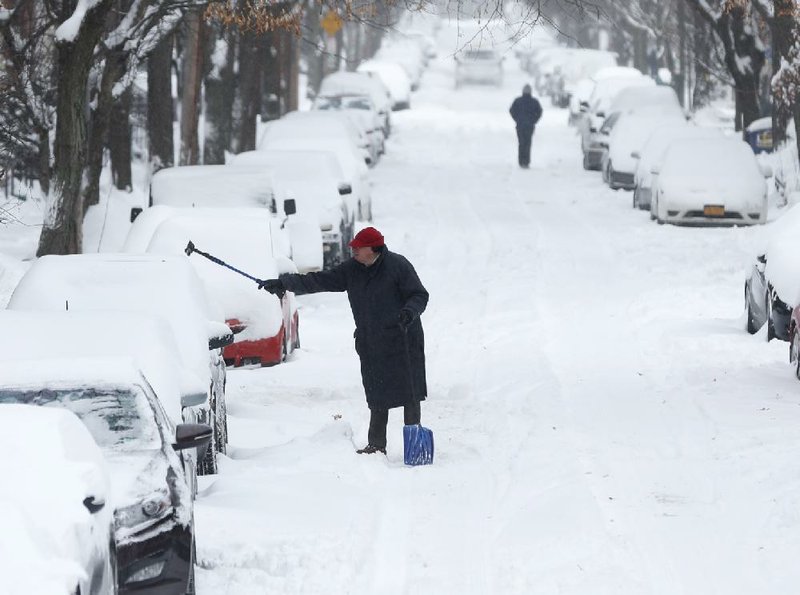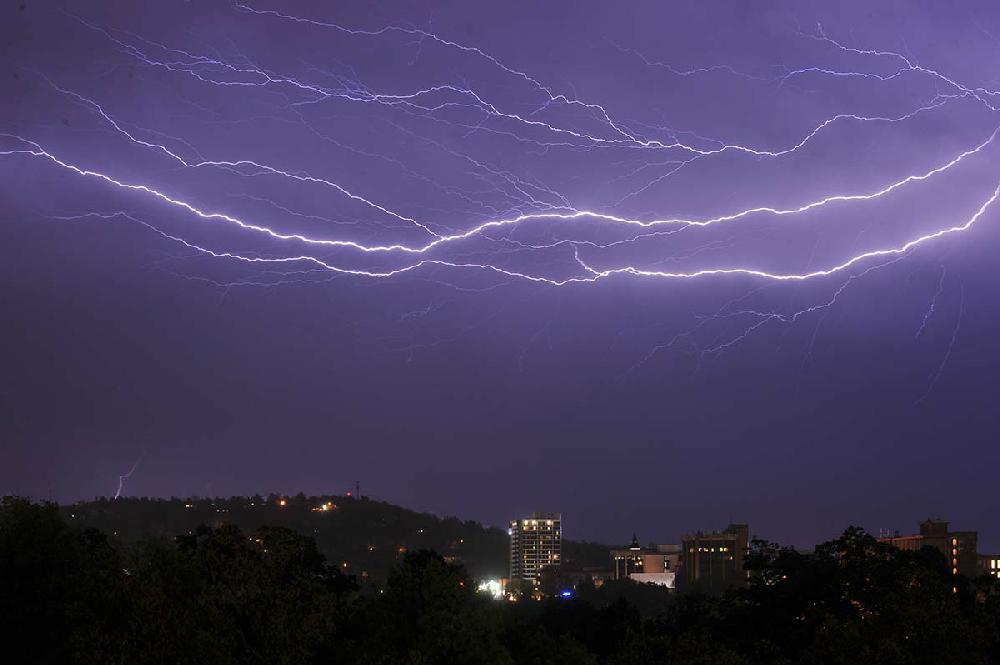BOSTON - Homeowners and motorists dug out across the white-blanketed Northeast on Friday as extreme cold ushered in by the storm threatened fingers and toes but kept the snow powdery and easier to shovel. At least 16 deaths were blamed on the storm as it swept across the nation’s eastern half.
While the snowfall had all but stopped by morning across the hard-hit Philadelphia-to-Boston corridor and many highways and streets were soon plowed and reopened, temperatures were in the single digits and teens, with wind chills well below zero.
“The snow is easy to move because the air was so cold when it snowed that it’s sort of light and fluffy stuff - but, uh, it’s cold,” Avalon“Nick” Minton said as he cleared the entrance to his garage and sidewalk in Arlington, Mass. “That’s the main part. It’s cold.”
Gusts between 30 and 45 mph blew in some areas, pushing newly plowed snow back into roadways. The wind was expected to drive wind chills to as low as minus 20 degrees in some areas Friday, according to the National Weather Service.
And officials from the Midwest to New England are preparing for another arctic blast in the next few days that forecasters said could be even worse.
The heaviest snow fell north of Boston in Boxford, Mass., which received nearly 2 feet. Nearly 18 inches fell in Boston and in western New York near Rochester. Lakewood, N.J., received 10 inches and New York’s Central Park got 6. Philadelphia got more than 6 inches.
Temperatures reached 8 degrees below zero Fahrenheit in Burlington, Vt. - with a wind chill of 29 degrees below zero - and 2 degrees in Boston. Wind chills there and in Providence, R.I., made it feel like minus 20 Friday morning, and the forecast called for more of the same into today.
Emergency officials warned that anyone spending more than a few minutes outdoors in such conditions could suffer frostbite.
Wellington Ferreira said the cold was worse than the snow as he cleared a sidewalk in front of Johnny D’s Uptown Restaurant and Music Club in Somerville, Mass.
“My ears are frozen,” he said.
Warming centers opened around the region, homeless shelters received more people, and cities took special measures to look after those most vulnerable to the cold. In Boston, police asked residents to call 911 if they saw anyone in need.
New York’s new mayor, Bill de Blasio, said the temperature in New York City was expected to plunge to near zero at nightfall. He urged residents to be mindful of elderly neighbors and to alert authorities to any homeless people who seemed in need of aid.
He also advised parents and children tempted by school closings and the fresh fallen snow to avoid sledding and spending long periods in city parks.
Massachusetts Gov. Deval Patrick ordered state offices to remain closed Friday, warning that temperatures were “very, very dangerous.” New York Gov. Andrew Cuomo and New Jersey Gov. Chris Christie declared states of emergency.
Coastal flooding closed roads in Massachusetts, including in Boston and Quincy. Voluntary evacuations were recommended in low-lying areas of Scituate and Duxbury, two coastal towns where high tides were expected, Patrick said.
In Newport, R.I., the Seaman’s Church Institute said it would stay open around the clock until the cold breaks to give mariners and others who work in or around the harbor a warm place to stay, shower and eat.
The light, powdery snow was a blessing in another respect: It did not weigh down electrical lines or tree limbs, and as a result, there were only a few thousand power failures across the Northeast.
Slick roads were blamed for several traffic deaths. In addition, a 71-year-old woman with Alzheimer’s disease froze to death after she wandered away from her rural western New York home. And a worker in Philadelphia was killed when a 100-foot high pile of road salt fell and crushed him.
Schools as far south as Washington, D.C., were closed Friday. Many government offices also shut down.
Major highways in and around New York City reopened after they were ordered closed Thursday, and airports across the region struggled to resume normal operations after U.S. airlines canceled about 2,200 flights Friday on top of 2,300 the day before.
Jeremy Shapiro, 73, of Manhattan, became stranded Thursday at New York’s Kennedy Airport. On Friday afternoon, he was still holding out hope for a spot flying standby so he could get to Santa Barbara, Calif.
He secured a cot, a pillow and a blanket after seeing about 150 passengers sleeping on cots at the terminal.
“It looked like an infirmary from World War I,” he said.
Severe cold also gripped the Midwest on Friday. In Wisconsin, the mercury dipped to minus 18 degrees in Green Bay, breaking by a single degree the record set in 1979. Fort Wayne, Ind., saw a record low of minus 10 degrees. And the mercury sank to 2 below zero at the Detroit airport.
Temperatures in the Midwest and the Northeast are expected to rise briefly over the weekend before the arrival of another blast of cold. Meteorologists said a “polar vortex” will send cold air piled up at the North Pole down to the U.S., funneling it as far south as the Gulf Coast.
More temperature records are expected to be broken during the short, yet forceful deep freeze that will begin in many places Sunday and extend into early next week.
“All the ingredients are there for a near-record or historic cold outbreak,” said Ryan Maue of Tallahassee, Fla., a meteorologist for Weather Bell. “If you’re under 40 [years old], you’ve not seen this stuff before.”
Cities and states were taking precautions Friday. Minnesota Gov. Mark Dayton ordered school canceled Monday statewide, the first such closing in 17 years, because of projected highs in the minus teens and lows as cold as 30 degrees below zero.
The cold air could refreeze roads that are wet or slushy from the weekend thaw, making travel dangerous.
The weather posed the first big test for de Blasio, who was sworn in a day before the heavy snow arrived in New York. De Blasio dispatched hundreds of plows and salt spreaders.
“I feel great about the response,” De Blasio said Friday. “We are vigilant. We are not out of this yet. As a great man said, ‘It’s not over until it’s over.’”
Emergency response times in the city were delayed by about a minute because of the storm, de Blasio said.
Subways were running Friday morning, although because cars had been stored underground on express tracks, trains were running on local lines for the start of the morning rush.
The Metropolitan Transportation Authority said bus passengers also could expect delays because of road conditions. The Department of Buses installed tire chains on all buses operating Friday, the authority said. The system was expected to run at about 85 percent capacity.
The authority’s railroads, Metro-North Railroad and Long Island Rail Road,were operating on weekend schedules. All of the authority’s bridges and tunnels remained open, though drivers were being asked to travel at reduced speeds.
Among commuters Friday, there were few complaints. At the Port Authority Bus Terminal, many said their trips to work were actually smoother than usual because motorists seemed to heed calls to stay off the roads.
“There were no cars on the road,” said Ziggy Siek, 33, an accountant from Clifton, N.J. “It was pretty nice.”
To avoid a snowy commute, Robin Denis, 56, a garment worker from Ronkonkoma, N.Y., said she had decided to spend the night in the city.
“I’ll probably be the only one at work,” she said.
In some of the farther reaches of the city, though, conditions were more challenging, with deeper snowdrifts and colder conditions.
In Queens, where even minor storms can cause severe flooding, water from the Hawtree Creek Basin was surging over its bank and pouring down the street. Within minutes it was halfway down the block and moving swiftly.
“As you can tell, a storm is a storm,” said Sal Franzese, 44, a carpenter whose house backs up to the creek. This storm, at least, was nothing compared to Hurricane Sandy, he said, which swept away the first floor of his home.
“Snow is a lot better than water,” he said. “The snow is like a godsend. The kids are having fun.”
De Blasio added his own personal touch to the storm’s cleanup, sending a photo via Twitter of him shoveling snow outside his home in Brooklyn.
“I urge all New Yorkers not to lift with your back; lift with your knees,” the new mayor said in televised remarks. At a news conference later, he said his son, Dante, 16, had taken over shoveling duties at the house, albeit belatedly.
“Dante is not an early riser, but he has now contributed to clearing the sidewalks of our city,” he said.
Information for this article was contributed by Michelle R. Smith, Rodrique Ngowi, Scott Mayerowitz, Geoff Mulvihill, Rik Stevens, Steve LeBlanc, Michael Dwyer, John Christoffersen, Jim Fitzgerald, Jonathan Lemire, Ula Ilnytzky, Karen Matthews, Chris Carola, Alanna Durkin, Patrick Condon, Jackie Quinn and Carson Walker of The Associated Press; by Michael Schwirtz, Al Baker, James Barron, Jessica Bidgood, Matt Flegenheimer, Michael M. Grynbaum and Andy Newman of The New York Times; by Brian K. Sullivan, Freeman Klopott, Lynn Doan, Annie Linskey, Phil Milford, Konstantin Rozhnov, Naureen S. Malik, Brendan Case, Terrence Dopp and Ann Koh of Bloomberg News.
Front Section, Pages 1 on 01/04/2014


